#japanese reading comprehension
Text
Japanese Reading Resources for Absolute Beginners
A question I encounter often is "How much Japanese should I study before I can begin reading in Japanese?"
From my experience as a learner and reader myself and from managing a Japanese book club for other learners I can honestly say that you can start way earlier than you probably think!
There are many resources that only require knowing hiragana. Those texts usually teach vocabulary through pictures and only use basic grammar.
Some are even simpler than that: The Japan Foundation's Hiragana Books are great for those, who are still remembering hiragana characters. Every short book introduces only 1-2 new characters, so it's a great reading exercise for those who've just started.

The free graded reader 「どうぞ、どうも」 by the NPO Tagengo Tadoku only uses the words 「どうぞ」 and 「どうも」 to write an entire story. Again, this makes for a great exercise in reading hiragana and understanding context. Another "level 0" recommendation by the same NPO would definitely be 「しろい?くろい?」. This book uses the full range of hiragana characters but the grammar is simple and all used vocabulary is illustrated.

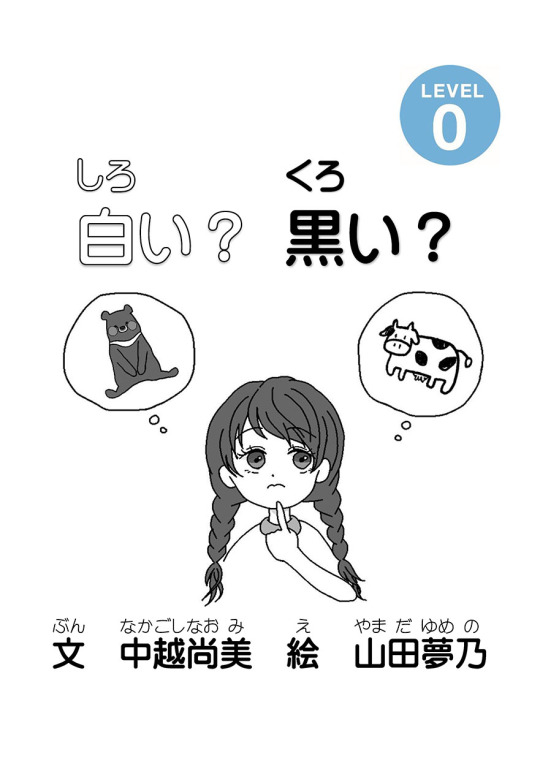
Another site with great resources for absolute beginners is Nihongo Tadoku Dōjō. If you have memorized both hiragana and katakana and know how the particles を and で work you will be able to read this text about stationary (ぶんぼうぐ) and understand everything by looking at the pictures!

The resources linked so far can all be accessed completely free on the linked websites. If you have the money to spare, please also have a look at the box 「スタート」 from the series reberubetsu nihongo tadoku raiburarī published by the NPO Tagengo Tadoku and ASK (affiliate link). This box includes 8 little books in very simple Japanese.
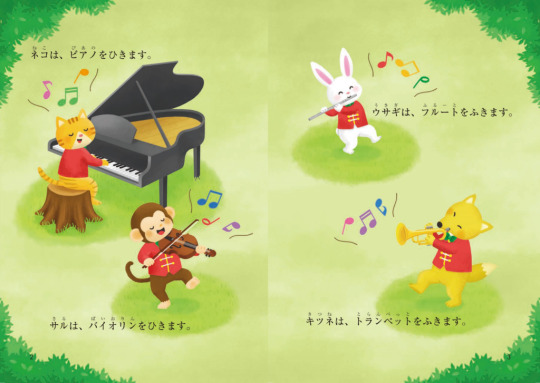
All these texts for absolute beginners will get you started reading in Japanese with very little knowledge of characters and vocabulary.
Reading in Japanese is a skill that requires practice. But once you get used to it, it can be such a valuable tool to reinforce new vocabulary and grammar. So please don't wait until you're "ready" before you start reading - start early at your own level!
#my book reviews#reading in japanese#study japanese#learning japanese#日本語#japanese books#やさしい日本語#free graded readers#free tadoku graded readers#nihongo tadoku dōjō#absolute beginner level#japanese langblr#japanese language#japanese reading comprehension#japanese free reading resources#japanese reading resources
647 notes
·
View notes
Text
Where to begin when reading native novels to work on reading comprehension?
So, you've made it to the point where you'd like to branch out and read some novels and children's books in Japanese? Then you've come to the right place! Let's talk about three helpful publishers (Kodansha, Kadokawa, and Shueisha) that can make reading native materials less daunting!
The Kodansha Aoitori Bunko Books (青い鳥文庫) were created and published by Kodansha with elementary schoolers in mind, so almost all kanji has furigana on it. The text is larger and there's normally a bit more spacing in between it (like our children's chapter books in English). Just like other children's chapter books, there are occasional photos included. Aoitori Readers include both original series as well as some translations of international literature (i.e., Little Women, Murder on the Orient Express, Sherlock Holmes, etc.). There are also some adaptations of other series はたらく細胞 (Cells at Work) Those books have blue around the cover.

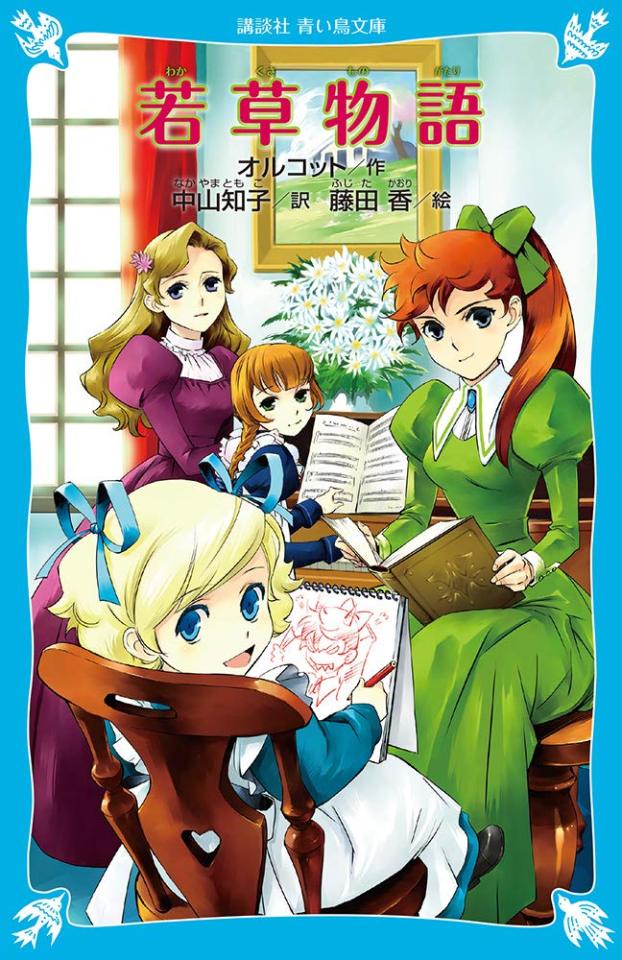
The Kadokawa Tsubasa Bunko Readers (角川つばさ文庫) operate on the same concept, except the series are normally on a more advanced level. With this in mind, they may use more advanced grammar than the Aoitori series. There are original series, but sometimes books/series for a higher comprehension levels will be adapted into Tsubasa Bunko Readers. This includes popular Japanese novels and series as well as international classics (i.e., Chronicles of Narnia, Pippi Longstocking, Anne of Green Gables, etc.). For adaptations of Japanese novels and series, there will be the "regular" version of the novel and then the Tsubasa Bunko version bc it's the same kanji, same grammar, same words. It'll also supply the furigana for those kanjis and might give little annotations or some photos here and there. For example, the award-winning novel 夜は短し歩けよ乙女 (The Night is Short, Walk on Girl) by 森見 登美彦 (Morimi Tomihiko) has both the "regular" publication and the Tsubasa Bunko version. Tsubasa Bunko Readers have green around the cover. Click on the links to get a preview of each version to compare and contrast.
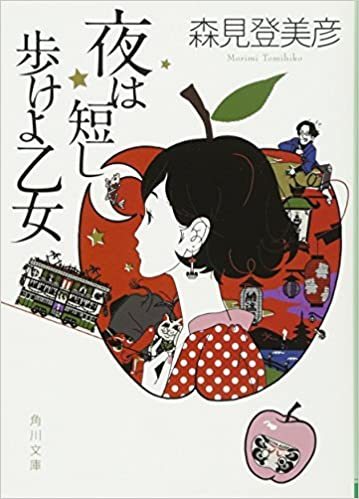

The Shueisha Mirai Bunko Books also operates the same. There are adaptations of manga series (like Kaguya-sama: Love is War and Demon Slayer) as well as original series. Mirai Bunko Readers have orange around the cover.
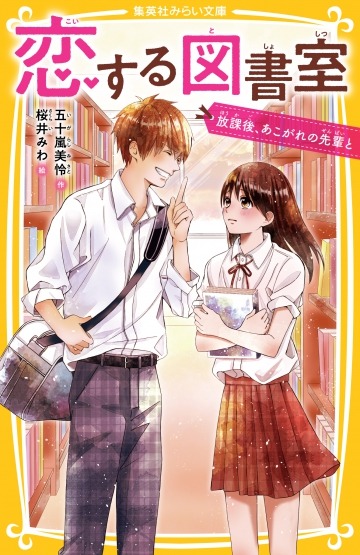
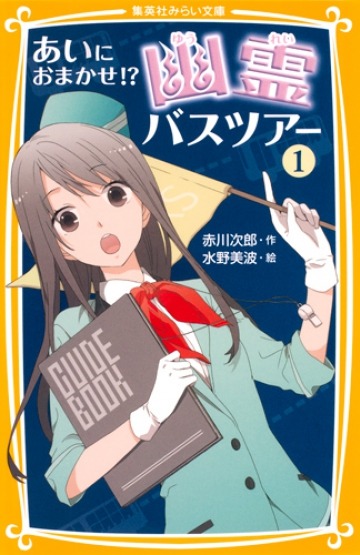
If you're worried about attempting to read any of these on your own, come suggest some of them for us to read together at the Seitokai Bookclub! (And even if it doesn't get selected immediately, someone might be interested in being a reading buddy with you :D).
Happy reading!
#onigiri thoughts#aoitori readers#tsubasa bunko readers#seitokai bookclub#japanese#japanese reading comprehension#mine#mirai readers#reading resources#looktoki#jpnstudynet#jlpt#japanese reading#jlpt n1#jlpt n3#jlpt n2#jlpt n4#jlpt n5#vocab#jlpt grammar#jlpt reading#jlpt studying#nihongo#learn japanese#kodansha#kadokawa#shueisha
418 notes
·
View notes
Text
JLPT N1 Lesson 9-3 Reading Comprehension「Point Card」【日本語能力試験】
#japanese reading comprehension#JLPT N1#JLPT#日本語#日本語勉強#日本語能力試験#日本語レッスン#日本語の練習#外国人技能実習生#Japanese#japanese language#learn japanese#study japanese#study languages#nihongo#online japanese#japanese teacher#japanese words#japanese lessons#japanese#jlpt
7 notes
·
View notes
Text
in addition to the tags on my latest rb: i absolutely think people can interpret characters and relationships differently and its not like one version is definitely right and the other wrong but it completely BAFFLES me how often i see people claiming akechi hates akira as if the game didn't literally spell it out to us twice (once in the form of morgana, and once in the form of maruki) that this isn't the case
and whoever thinks akira hates akechi is just projecting there is literally no other way
#friendly reminder that morganas “you dont actually hate joker right” isnt even correctly translated#he says 気に入る in japanese iirc#which can mean “liking” or “being fond of” or “taking a fancy to” etc#in other words morgana LITERALLY SPELLS IT OUT TO US THAT AKECHI *LIKES* JOKER#and sometimes i remember this and then wonder if persona reddit has no reading comprehension whatsoever#txt
920 notes
·
View notes
Text

One of the panels of all time honestly.
#DOMINIQUE VANITAS SOLIDARITY#I'm gonna be honest the fine details of this conversation got away from me a bit#beyond my japanese reading comprehension#but even so I can tell it was incredible#noé lovers unite lmao#and I am going to REALLY enjoy the translation tomorrow lol#but god even on its own this panel is so good#big meme energy honestly#vnc#manga#vnc spoilers#vnc 60
159 notes
·
View notes
Text
Koisenu Futari Production Journal ⑩ (translation pt. 1)
part 1 of 3 | part 2 | original article here
this is kind of long (and it's only part one!) so I'm putting it under the cut. if you catch any errors, let me know!
Hello, I am Sayaka Takahashi, the costume director of Koisenu Futari.
In a drama, the costuming of a character plays the fundamental role of adding realism to a characterization. In addition to that, however, I think costuming expresses a “background” that can’t be conveyed by the dialogue or storyline alone, and gives viewers the chance to dig deeper into the characters.
I especially tried to keep this in mind while styling the characters for this show.
Like many, I first heard of the existence of aromantic and asexual people while working on this show. Although there were many new surprises in this regard, reading through the script and understanding the characters better helped me to understand that they were all very fascinating. I soon began working on expanding upon the impressions I got through the costumes.
Approachable and somewhat delicate, despite their strong sense of individuality—in order to convey this impression, I used a variety of colors in the composition of each character’s outfits. The costumes needed to be heavily emphasized in order to come across as colorful in a show with lots of location shooting, but I tried to add color freely without getting boxed in by that.
I will specifically explain the costuming processes of Sakuko, Takahashi, and Kazu.
⚫Sakuko’s Costumes
When styling Sakuko, I tried to ensure that she immediately came off as a bright and likeable character.
At first, I developed a soft, fluffy look using pastels and muted colors, and incorporated recognizable trends such as frills, see-through fabrics, and puffed sleeves in order to create the image of a girl who has fun with both her work and her fashion.
I also expressed her sociable nature using the colors of her jackets and the balance of her backpack. However, after her encounter with Takahashi, she begins to realize that she had been subconsciously changing herself to suit the needs of the people around her.
When Sakuko goes from realization to acceptance, we see her world become more vivid and colorful. This is when her clothes and accessories begin to gradually change. We decided that she had liked rather large earrings even before her realization, and used those alongside her backpack to emphasize her individuality.
While the outfit she wears to visit Takahashi’s home for the first time is a normal commuting outfit, the balance of color used to express her joy and excitement at finally being able to relate to someone, as well as the vigor with which she innocently barges into the house, makes it one of her main looks.
And in episode 3, the coat Sakuko comes across during the shopping scenes in episode 3 becomes a vital part of her awakening to a newfound sense. For this scene, we looked for something very impactful and something that, above all else, suited Sakuko the best. Ms. Kishii looks very good in vivid colors, especially red, so we unanimously decided on this bright red coat during the costume fittings. This coat becomes the start of Sakuko’s discovery of a new part of herself as she begins to try out clothes and accessories she had never chosen to wear previously.
Starting from episode 6, there is a clear change in Sakuko’s appearance, where Takahashi’s grandmother’s influence can be seen. Her style begins to broaden as she begins to embrace vintage clothing and accessories, such as brooches, and begins incorporating more masculine elements. Specifically, we introduced elements that we had been avoiding up through episode 5, such as second-hand clothing, denim, primary colors, black, and large earrings.
I hope we were able to convey the relief and freedom Sakuko feels as she chooses to wear the things that she likes without having to care about what others think of her.
thanks to @dollopheadsandclotpoles and many others for their kind words of encouragement - I hope you enjoy!
part 2 | original article here
#koisenu futari#sakuko#miwa translates#i can't tell if it's my reading comprehension skills deteriorating or if the text was too awkwardly written to begin with#but this was weirdly difficult to translate#especially since it's technically the first time i've translated anything of this scale from japanese to english#it's a fun article though!
43 notes
·
View notes
Text
if you refer to mizuki with he pronouns i literally hope you get crushed by a giant boulder and go to hell
#'oh they use boku which is masculine it's all bait-' SHUT. UP.#BOKU IS NOT 'MASCULINE' THAT'S NOT HOW JAPANESE WORKS YOU ARE ALL JUST FORCING WESTERN STANDARDS WHERE THEY DON'T BELOMG#BECAUSE YOU CAN'T COMPREHEND A LANGUAGE NOT HAVING STRICTLY GENDERED WORDS I HATE YOU ALL#mizuki is very very very very extremely transfem it's NOT '''''bait''''' if you had an ounce of reading comprehension you'd understand that#BUT WHAT THE FUCK EVER. EXPLODE
38 notes
·
View notes
Text
I forgot how difficult it is to read Spy x Family in Japanese when your Japanese is really not very good at all
#every time i tell my japanese friends i have spy x family in japanese they're like ohhh wow but i think it's probably really hard for you#and i'm like thanks! it is!#takes me like 20 minutes to read a single page with 2 lines of dialogue!#anyway i moved the scattered vocab lists i'd copied into my notebook into a comprehensive excel spreadsheet#so now it'll be easy for me to review the most important words more often#so that hopefully i won't have to spend *as much* time looking up every other word
14 notes
·
View notes
Text
ugh all of my vocalsynth mutuals are so cool and also know way more japanese than me and i feel so inferior and afraid of everyone YOU'RE ALL SO COOL I'M GOING TO GO CRAZY
#kiki was here#kiki.txt#i was studying japanese but i had to stop because health problems were making it near impossible#i'm working on managing my disabilities now and i hope i can pick my studies back up#my jp skills amount to being able to read kana#a tiny handful of kanji are recognizable#and with a dictionary i probably know enough grammar rules to get the gist of something#i have very little listening comprehension and cannot write or speak it#whenever i see fellow vocaloid fans who know jp i feel so intimidated#i am like a puny ant LOL
7 notes
·
View notes
Text
remember before getting into dunm'eshi seeing a bunch of people going "the only way to survive this fandom is to block on sight" and I get it now..........oh my god I get it now
#you'd think this'd be about people talking about#idk my least fav chara or ship or arc or whatever but NO#it's about people liking the stuff i like all wrong oh my god#OH MY GOD#i haven't been in a fandom with this little reading comprehension in AGES#everything is in extremes around here! no space for nuances in sight!!!#if i have to see one more person going “this is canon” about something that obviously isn't I'm going to scream#which is so sad because this is actually one of the best manga I've read in years#but the fandom is SO ANNOYING OH MY GOD IT'S SO ANNOYING#they said block on sight i thought in a controlled way but no#I'm just blocking the whole damn tag im so sorry to miss kui she didn't deserve this#i hope the japanese fandom is better for her sake
2 notes
·
View notes
Text
anime and manga translators who reverse the japanese name order to the western order should be hunted for sport
#WHY#japanese put SURNAME first#if people are dumb that's their problem the rest of us have reading comprehension
6 notes
·
View notes
Text
Augh, ch 3-4 ends not long before the end of the first set in the Seiin vs. Keisei match. I wanna know who takes it, but it’s late and I have work tomorrow morning so I don’t really wanna start another subchapter… I know how I’d have the point progression in this match if I were writing it, so I’m looking forward to seeing if that’s how it actually goes.
Keisei is a slow starter, and Seiin’s winning against them at first. We end ch 3-4 with Keisei narrowing the 23–18 gap to 23–21 in the blink of an eye, them finally having kicked into gear and the momentum completely in their favor.
Keisei would win this one, and then Seiin would wrest the second set from them after a tough battle despite Keisei now being in top form, and they’d get close to taking the third as well but then fall just that little bit short, at least in part due to exhaustion from this being the second game in a double-header and their match against Miboshi having dragged out. The second set would probably go into a deuce, but I dunno about the third. Maybe by one point, or else they just miss bringing to to a deuce. (Also it’s pretty much a given that Haijima collapses afterward. He doesn’t have quite that much stamina.)
So, basically the same as the Fukuhou match but scaled down to three sets and with the opposite outcome.
I’m guessing the entirety of ch 3 is the Seiin-Keisei match and then ch 4 is the last two games and Seiin watches them win. Probably the very end of the finals is from Chika’s POV, so we get to experience him being swayed to accept Wakatsuki’s offer as it happens, since he’s currently adamantly against leaving Seiin but we know he does transfer to Keisei for second and third year.
#auuugh i wish i could read faster in japanese…#i'm definitely faster (and have higher comprehension) than when i read the first arc#but it's not enough#2.43 seiin koukou danshi volley bu#2.43#ebw.op
2 notes
·
View notes
Text
日本の歴史366 Day 20
1月20日 Summary:
In a post-WW2 Japan, school lunch began to be offered to all children across the nation. The goal was to keep children from being malnourished during the ever-so-important growth period that children experience. This also helped to lift the burden on struggling households.

Vocab beneath break:
学校給食 がっこうきゅうしょく school lunch
おかず side dish
戦後 せんご postwar period; period after Second World War
育ちざかり そだちざかり growth period (in children)
栄養不足 えいようぶそく malnutrition
全国的 nationwide; throughout the nation; throughout the country; countrywide
行われる おこなわれる to be done; to be practiced; to be practised; to take place; to be held; to be prevalent; to be in fashion; to be in vogue; to be current; to come into use
大盛り おおもり large serving; large portion
貧困 ひんこん poverty; penury; need; destitution
家庭 かてい household; family; home
対象 たいしょう target; object (of worship, study, etc.); subject (of taxation, etc.); recipient
配る くばる to distribute; to hand out; to deliver; to deal out; to serve out
規模 きぼ scale; scope; structure; plan
試験的 しけんてき experimental; provisional
都市 とし town; city; municipal; urban
広がる ひろがる to spread (out); to extend; to stretch; to reach to; to get around; to fill (e.g. a space)
簡素 かんそ simple; plain; modest
脱脂粉乳 だっしふんに��う powdered skim milk; skimmed milk powder; non-fat dry milk
#shay's taking notes#japanese history 366#japanese history#japanese culture#japanese language#learn japanese#japanese grammar#japanese#study japanese#japanese figures#vocab#jpnstudynet#japan#learn through reading#reading practice#japanese reading comprehension#learning through immersion#immersion through reading#ah queue! bless you
5 notes
·
View notes
Text
lord help me im breaking out duolingo again
#woof#toxic trait is that i studied japanese very seriously for like 3 years and then dropped it#took classes for a couple yrs and studied on my own on and off#my listening comprehension is still ok i can read a little but ive never seriously gotten back into it
10 notes
·
View notes
Text
duolingo keeps giving me listening exercises even though i have those turned off in accessiblity settings, cool cool cool
#like im not hoh i just have it turned off bc turning off sound helps my reading comprehension a lot for japanese#but either way it's uhhhh not great duolingo!!!#i checked my settings too and toggled it on and off and it didn't work#considering abandoning duo altogether but i should like probably not make life decisions tonight bc i am Stressed
5 notes
·
View notes
Text
yo like literally why did they decide to make "jumpy" a thing in the english translation of 999. she's literally just calling junpei the entire time. also in the japanese santa's whole like "do you speak japanese" line is replaced with him explaining "like santa claus" which makes WAY more sense
#i'm replaying 999 in japanese#am i gonna end up replaying all the spike chunsoft games i own in japanese after this? maybe#it's so effective for strengthening reading speed & comprehension#& listening skills to some extent
3 notes
·
View notes